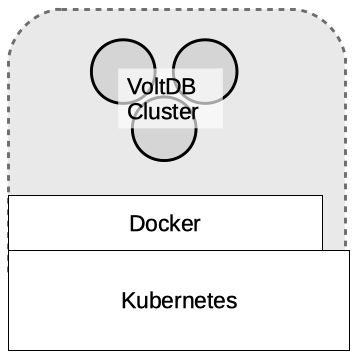Archive
Kubernetes is an environment for hosting virtualized applications and services run in containers. It is designed to automate the management of distributed applications, with a particular focus on microservices. VoltDB is not a microservice — there is coordination between the nodes of a VoltDB cluster that requires additional attention. So although it is possible to spin up a generic set of Kubernetes "pods" to run a VoltDB database, additional infrastructure is necessary to realize the full potential of Kubernetes and VoltDB working together.
VoltDB Enterprise Edition now provides additional services to simplify, automate, and unlock the power of running VoltDB within Kubernetes environments. There are six key components to the VoltDB Kubernetes offering, three available as open-source applications for establishing the necessary hosting environment and three provided by VoltDB to Enterprise customers. The three open-source products required to run VoltDB in a Kubernetes environment are:
Kubernetes itself
Docker, for managing the container images
Helm, for automating the creation and administration of VoltDB in Kubernetes
In addition to these base requirements, VoltDB provides the following three custom components:
Pre-packaged docker image for running VoltDB cluster nodes
The VoltDB Operator, a separate utility (and docker image) for orchestrating the startup and management of VoltDB clusters in Kubernetes
Helm charts for initializing and communicating with Kubernetes, the VoltDB Operator and its associated VoltDB cluster
The remainder of this chapter provides an overview of how these components work together to support running virtualized VoltDB clusters in a Kubernetes environment, the requirements for the host and client systems, and instructions for preparing the host environment prior to running VoltDB. Subsequent chapters provide details on configuring and starting your VoltDB cluster as well as common administrative tasks such as:
Starting, stopping, and modifying the VoltDB cluster
Managing the database schema and configuration
Finally, an appendix provides a full list of the Helm properties for configuring and controlling your VoltDB clusters.
Kubernetes lets you create clusters of virtual machines, on which you run "pods". Each pod acts as a separate virtualized system or container. The containers are pre-defined collections of system and application components needed to run an application or service. Kubernetes provides the virtual machines, Docker defines the containers, and Kubernetes takes responsibility for starting and stopping the appropriate number of pods that your application needs.
So the basic architecture for running VoltDB is a VoltDB database running on multiple instances of a Docker container inside a Kubernetes cluster.

However, out of the box, VoltDB and Kubernetes do not "talk together" and so there is no agreement on when pods are started and stopped and whether a VoltDB node is active or not. To solve this problem, VoltDB provides an additional service, the VoltDB Operator that manages the interactions between the VoltDB cluster and the Kubernetes infrastructure. The Operator takes responsibility for initializing and starting the VoltDB server instances as appropriate, monitoring their health, and coordinating changes to the configuration.
To further simplify the process, VoltDB uses the open-source management product Helm to integrate Kubernetes, Docker, and VoltDB under a single interface. Helm uses "charts" to define complex management operations, such as configuring and starting the Kubernetes pods with the appropriate Docker images and then initializing and starting VoltDB on those pods. Simply by "installing" the appropriate Helm chart you can instantiate and run a VoltDB database cluster within Kubernetes using a single command.
Once the database is running, you can use standard VoltDB command line utilities to interact with and manage the database contents, such as modifying the schema or initiating manual snapshots. However, you will continue to use Helm to manage the server process and cluster on which the database runs, for activities such as stopping and starting the database. Figure 1.1, “Kubernetes/VoltDB Architecture” shows the overall architecture of using VoltDB, the VoltDB Operator, and Helm to automate running a VoltDB database within Kubernetes.